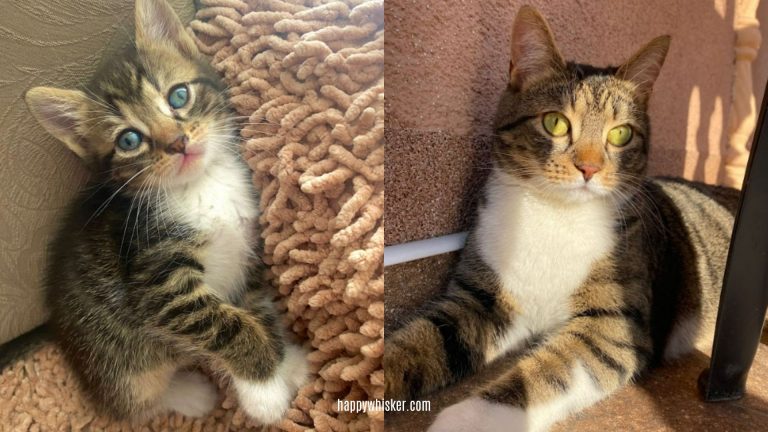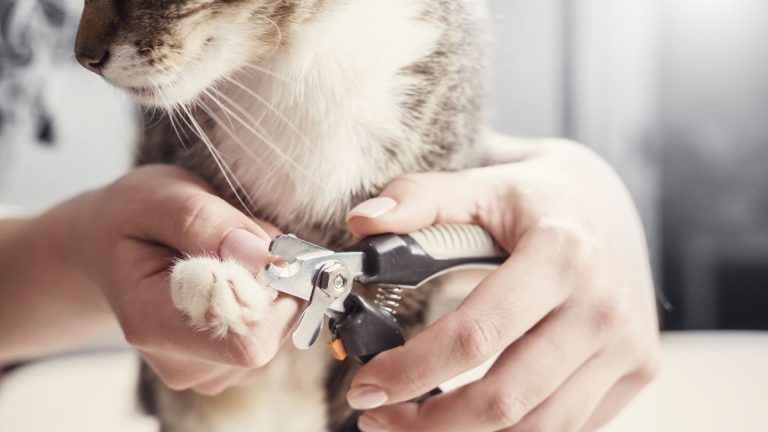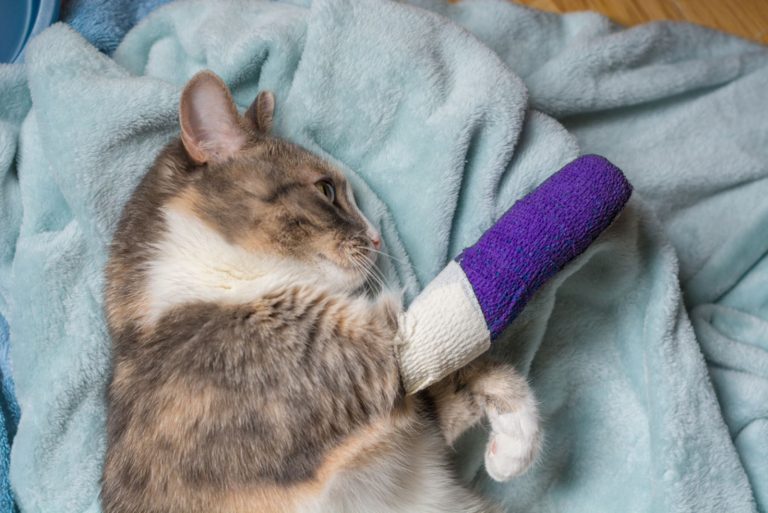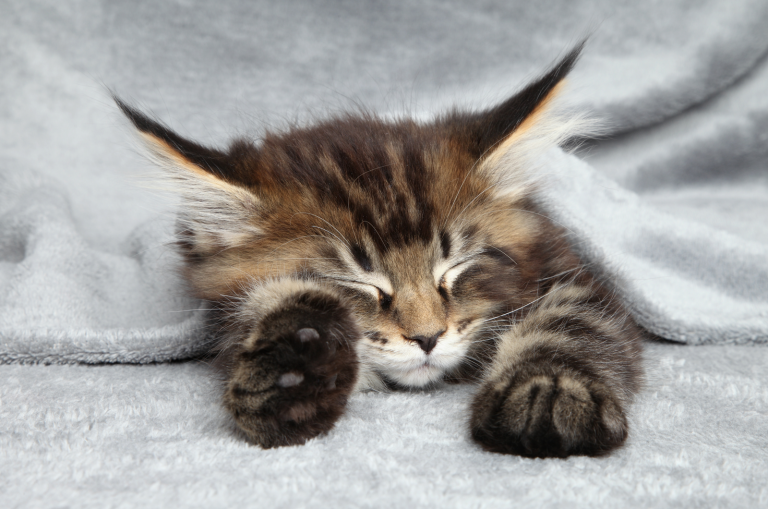A Complete Guide To The Cat Vomit Color Chart
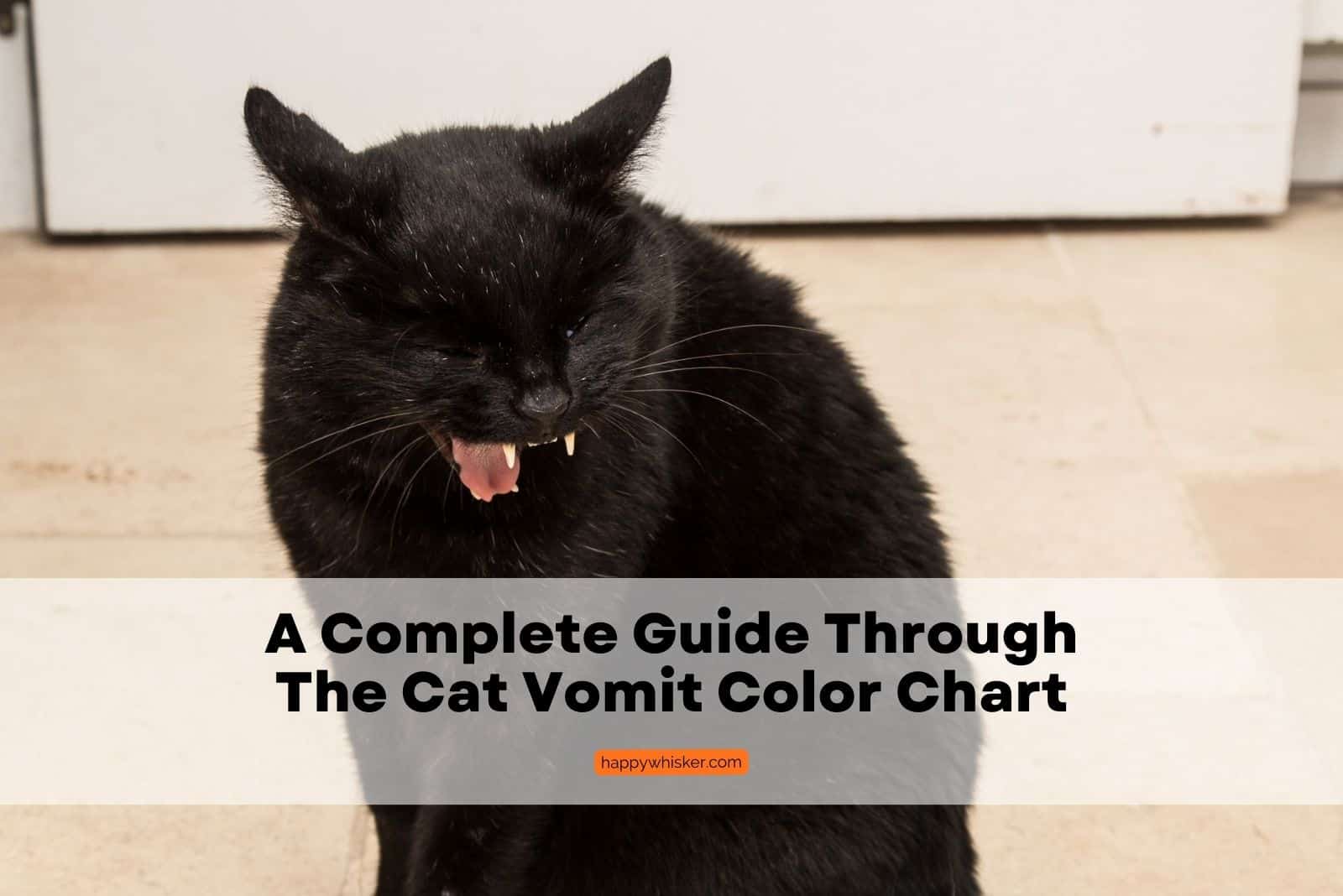
Hello cat owners!
Are you tired of guessing what your cat’s vomit might mean? If you are, you’ve come to the right place!
To aid in identifying potential health concerns, I have created a comprehensive guide to the cat vomit color chart!
From the tell-tale signs of hairballs to vomit that may be indicative of a serious health issue, we’ll break down every shade and texture of cat vomit.
With the help of the chart I’ve prepared, you’ll be able to decipher your cat’s stomach issues in no time, so let’s begin!
The Importance Of The Cat Vomit Color Chart
Everyone’s cat vomits from time to time, right? The trick is to know when to take a cat vomiting more seriously, and when it’s not such a “big deal”.
Vomiting in cats can be caused by non-serious issues such as eating too fast, or eating indigestible objects or hairballs.
On the other hand, vomiting in cats can be an indicator of a serious health issue, such as gastrointestinal issues, various infections, and even certain types of cancer.
So, how do you know when a cat’s vomit indicates a non-serious health issue, and when it’s a sign of a serious health issue? You guessed it – using a cat vomit color chart!
From hairballs to serious illnesses, the color chart of cat vomit can be your go-to tool to identify potential medical problems your cat might be experiencing.
Without further ado, let’s see what the cat vomit color chart looks like, and what each vomit color means!
Cat Vomit Color Chart
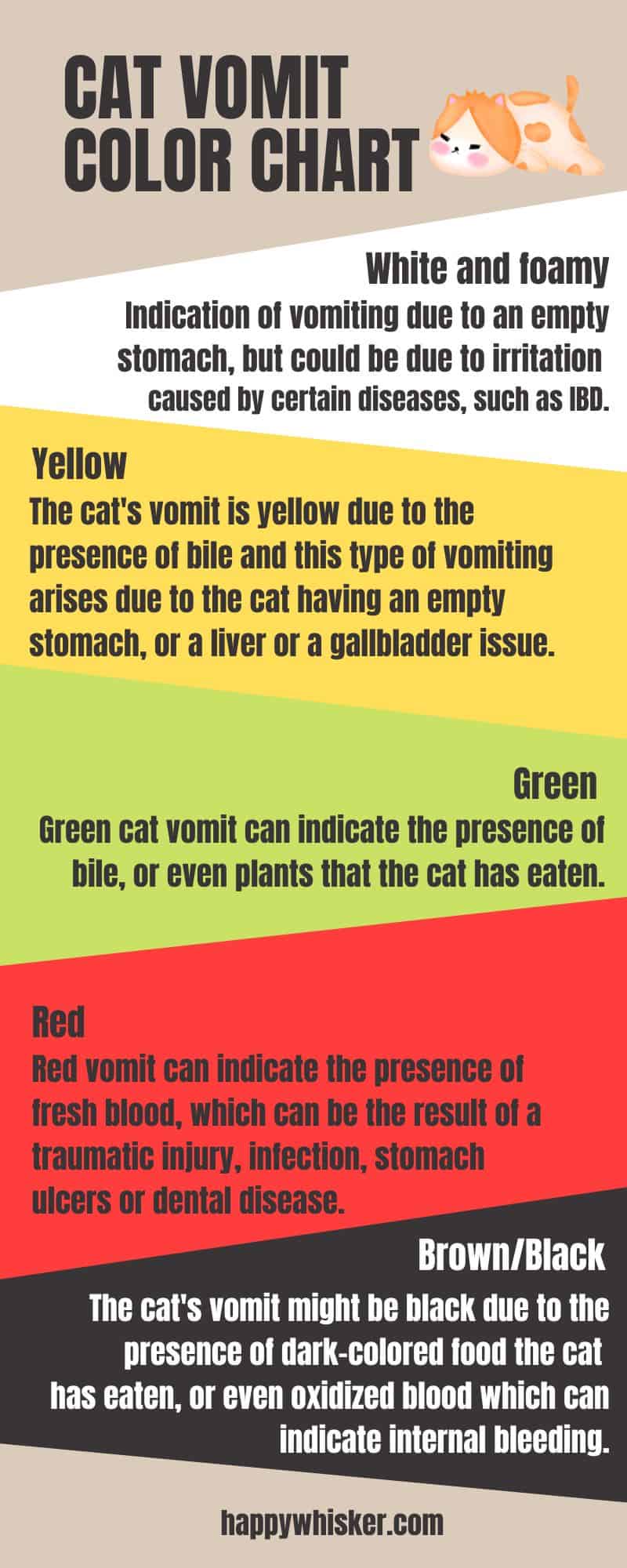
1. White Foamy Cat Vomit
White foam is an indication that the cat has nothing to vomit and is likely to be having an empty stomach reaction.
Some gastrointestinal conditions, such as stomach cancer or inflammatory bowel disease, can irritate and inflame the stomach and intestines, causing a buildup of air and fluid in the stomach that causes white, foamy vomit.
In gastroesophageal reflux disease (GERD), the esophagus becomes inflamed and irritated when stomach acid flows back into it. In fact, one of the most common symptoms of GERD in cats is white, foamy vomit.
2. Yellow Cat Vomit
Yellow cat vomit may indicate bile, which is produced by the liver to aid in digestion and is usually seen when a cat has an empty stomach.
Bile is a yellowish fluid that aids digestion when released into the small intestine. Cats may vomit bile, which can appear green or yellow, if they are vomiting stomach fluids due to an empty stomach.
If a cat has a liver or gallbladder issue such as infection, inflammation, or cancer, it can have yellow vomit as well. Eating certain foods or medications can also cause the vomit to turn yellow too, although this is very rare.
3. Green Cat Vomit
A cat’s vomit may be green or yellow if it contains bile. This may occur if a cat has an empty stomach and is merely passing fluid from the stomach, or it may occur if the cat has a liver or gallbladder disorder such as an infection, inflammation, or cancer.
Another potential cause of green cat vomit is having too much grass for a snack!
Cats may consume grass or other plant matter occasionally and that’s nothing to be worried about. The green tint of the vomit may result from this.
4. Red Cat Vomit
A cat’s vomit may be red in color if it contains fresh blood.
Traumatic injuries, viral or bacterial infections, stomach ulcers, inflammatory bowel disease, certain medications, dental disease, kidney failure or liver disease can all cause fresh blood in your cat’s vomit.
Eating certain foods such as beets can also make the cat’s vomit red in color.
However, if you have been carefully tracking what your cat has been eating and you know your cat has not eaten anything red, please go to the vet.
The vet will try to find what’s causing your cat’s vomit to contain blood, and determine the proper treatment for it.
5. Brown/Black Cat Vomit
Brown or black cat vomit may be caused by the presence of dark-colored food that has been digested and is now being expelled as waste, or it can be due to the presence of oxidized blood.
If the vomit contains digested blood (or when the blood has been in the stomach for a while and it turns dark), that’s a cause for concern. Gastrointestinal bleeding (or GI hemorrhage) should not be taken lightly.
Stomach tumors are the most frequent cause of gastrointestinal bleeding in cats. Stomach ulcers are a potential cause of GI bleeding as well.
A number of toxins, such as rat poison can cause the bleeding as well. However, no matter the cause of the bleeding, one thing is certain – you need to take your cat to the vet as soon as you can!
What About Cat Vomit Texture?

One way to determine the cause of your cat’s vomiting is by examining the texture of the vomit.
From chunky and grainy to watery, foamy, and stringy, we’ll take a closer look at the potential causes of each cat vomit texture, so let’s jump in!
1. Chunky/Grainy
This texture can occur when a cat has vomited undigested food. It may be a sign that the cat is eating too quickly or not chewing its food properly.
Cats who eat too quickly may not chew their food properly before swallowing, resulting in undigested food being vomited.
2. Watery
This texture can occur when a cat has an empty stomach and is vomiting bile. It can also be a sign of stomach irritation or inflammation, such as gastritis.
It is also possible for a cat’s vomit to be watery because the cat drank too much water. Cats drink too much water for a variety of medical reasons, such as diabetes mellitus and renal dysfunction.
3. Foamy/Frothy
If your cat is vomiting white foam, it is most likely due to an empty stomach.
Similar to humans, cats have hydrochloric acid and other gastric secretions in their stomachs to help in food digestion.
The accumulation of liquid and acid can irritate the stomach and cause your cat to vomit if they skip a meal or aren’t fed on time.
4. Stringy
This texture can occur when a cat has vomited worms. Yes, you read it right; cats can throw up worms if they are suffering from a parasitic infection.
Intestinal parasites such as roundworms, tapeworms, and hookworms can infect cats and cause them to vomit the worms. It is possible for the worms to be observed in a cat’s feces as well.
Cat Vomit Vs. Hairballs: Know The Difference
Being a cat owner comes with a bunch of little tasks, and one of them is – knowing how to differentiate between cat vomit and hairballs!
Cat vomit is the material expelled from a cat’s stomach through its mouth. It can consist of (un)digested food, bile, or other stomach contents.
On the other hand, hairballs are small, round clumps of hair that cats expel through their mouth by coughing or vomiting. They are a natural occurrence in cats, considering cats self-groom daily.
It is possible for cats to throw up some other content together with the hairball, causing you to wonder: Did my cat just vomit, or was this just a “hairball expulsion”? The following chart will help you answer that!
How To Distinguish Between Vomit And Hairballs In Cats
[table id=429 /]
Just in case, let me provide you with some visual evidence of the differences between vomit and hairballs.
This is what a cat’s vomit looks like:
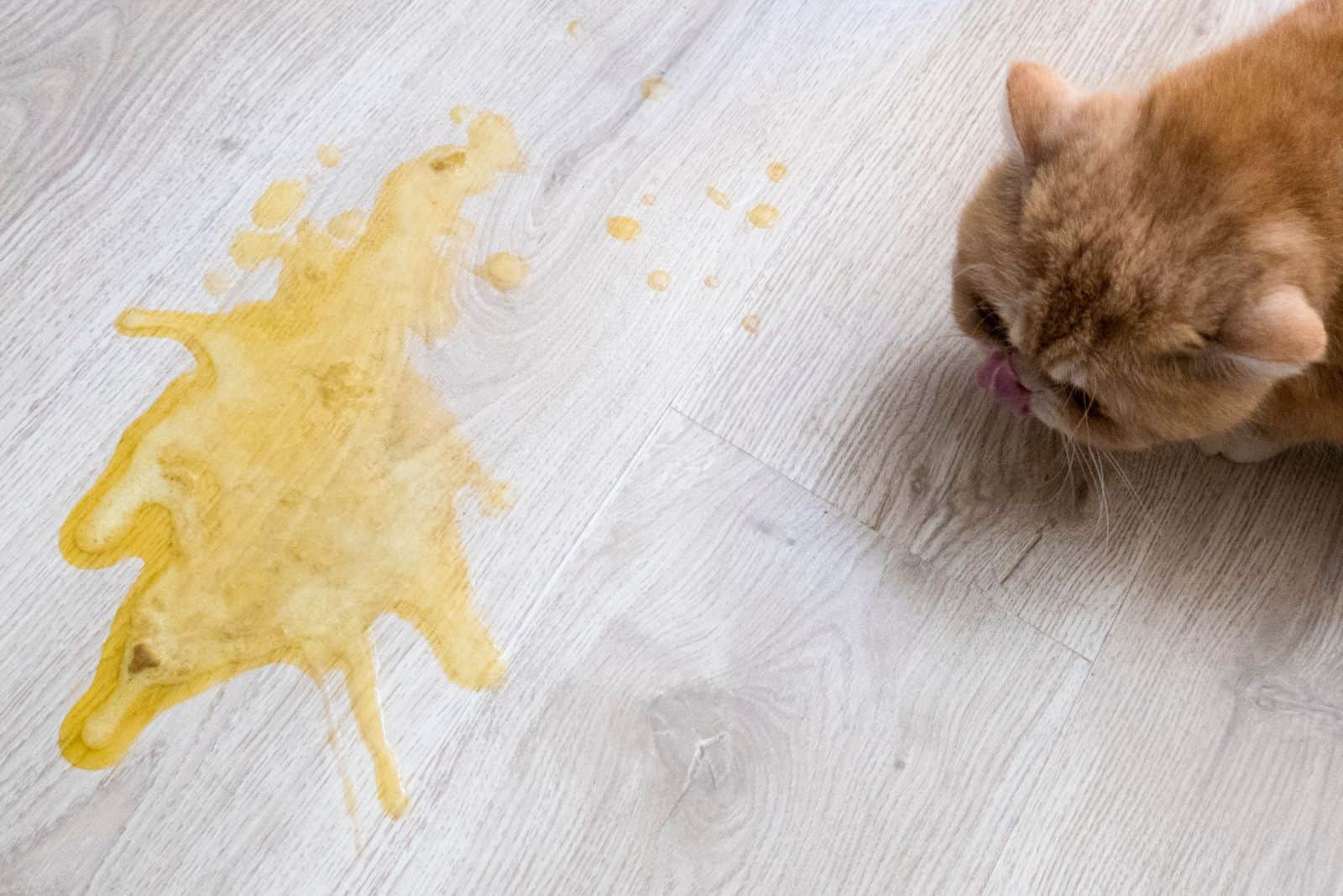
And this is what a hairball vomit looks like:

Vomiting Vs. Regurgitation: Know The Difference
Are you ever unsure of whether that suspicious liquid coming out of your pet’s mouth is vomit or regurgitated food? If so, you’re not alone! It can truly be difficult to differentiate between the two.
Vomiting and regurgitation are both related to the digestive system, but they are different processes.
Vomiting is the forceful ejection of stomach contents through the mouth. The expelled material is usually a mixture of undigested food, stomach acid, and mucus.
Regurgitating occurs when a cat is unable to begin digesting food and the undigested food is discharged from the esophagus through the mouth.
How Can I Distinguish Between The Two Based On How They Look?
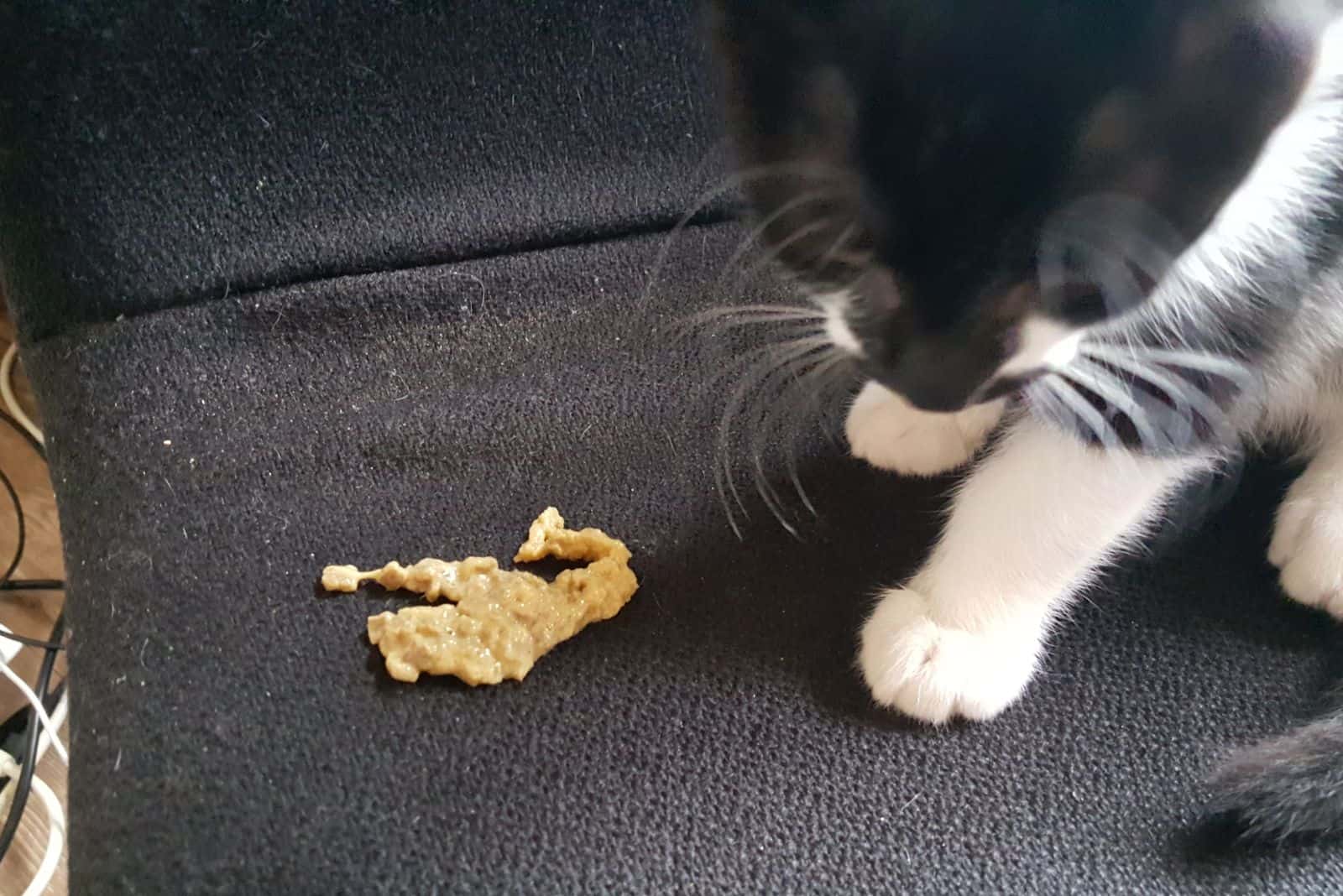
Vomiting and regurgitation in cats can have some similarities in terms of appearance, but there are also some differences.
The Look Of Cat Vomit
Vomiting in cats is usually characterized by the presence of stomach acid and bile, which can cause the vomited material to appear yellow or greenish.
Vomit may also have a strong, unpleasant odor. Vomiting debris may also contain undigested food, hair, and in some cases, foreign items the cat has swallowed.
The Look Of Regurgitated Content
Regurgitation in cats, on the other hand, is typically characterized by the presence of undigested food, which can take the appearance of a tube or a spherical ball.
The content is frequently wet and slimy in texture. It usually has a neutral or slightly acidic odor.
The bottom line is, vomit is more acidic, has more stomach bile, and has a stronger odor, whereas regurgitation contains partially digested food, is frequently wet and slimy, and has a weaker odor.
Occasional Vomiting: Normal Or A Cause For Concern?
It’s normal for cats to occasionally vomit, just like it’s normal for humans to occasionally experience stomach upset
For example, there is nothing to be worried about if your cat’s vomiting is due to eating something they shouldn’t have (such as a brownie), or occasionally due to a hairball.
However, if a cat is vomiting frequently or if the vomiting is accompanied by other symptoms, it’s important to consult with a veterinarian to rule out any underlying health issues.
When Should I Take My Cat To The Vet?
Although occasional vomiting is common, it may sometimes indicate a more serious underlying medical condition. So how can I tell if my cat needs urgent care or not?
Here is what I tell cat owners that ask me when their cat’s vomiting needs veterinary care.
You should take your cat to the vet:
• If your cat is vomiting frequently, more than once or twice a week
• If your cat is vomiting blood
• If your cat is displaying other symptoms of ill health, such as lethargy, weight loss, unusual behavior, etc.
• If your cat is vomiting undigested food more than is normal
However, even if your cat does not “tick all the boxes” I’ve listed above, if you’re worried about your cat’s vomiting, go see a vet! A quick vet visit never hurt anyone.
FAQ

Why Does My Cat Vomit?
There are many potential causes of vomiting in cats, such as eating too much too quickly, eating spoiled food, eating non-food items (such as yarn or plastic), ingestion of a poison, hairballs, medication, intestinal parasites, bacterial or viral infection, or organ-related diseases such as liver disease.
What Kind Of Cat Throw Up Is Concerning?
Bloody vomit and yellowish-green and foamy vomit (vomit with bile) are a cause for concern. If you notice your cat’s vomit looking like this, please, take your cat to the vet as soon as you can.
Also, note that persistent vomiting is concerning as well, no matter what the cat’s vomit looks like.
What Does It Mean If A Cat Vomits Blood?
If a cat vomits blood, this is an indication of a serious medical problem that should be treated right once by a veterinarian.
Vomiting blood might be caused by anything from gastrointestinal ulcers or tumors to infection, pancreatitis, or poisoning.
How Can I Tell If My Cat Is Sick From The Vomit?
The color and texture of the vomit can give you some clues as to what might be causing your cat’s illness.
Cat vomit that is yellow or green might be an indication your cat is sick. Also, if the cat’s vomit is bloody or contains mucus, the cat might have an intestinal problem.
If there are hairballs in the vomit, this might suggest (you guessed it!) a hairball problem.
Finally, if the vomit has a very strong and unpleasant odor, it may indicate a more serious health issue as well.
Wrapping Up
And there you have it folks! We’ve gone over what every color within the cat vomit color chart means, and when you should be worried (and when not so much!).
Cat owners, by understanding the potential meanings behind different vomit colors, you’ll be able to recognize when your cat vomiting is an emergency and when it’s not.
With the color chart I’ve provided, I’m sure you’ll be able to react quickly if needed, and provide your cat with the best care possible!
Now that you know all about the cat vomit color chart, let me introduce you to something (kind of) similar, and equally necessary for cat owners – a cat poop color chart!

